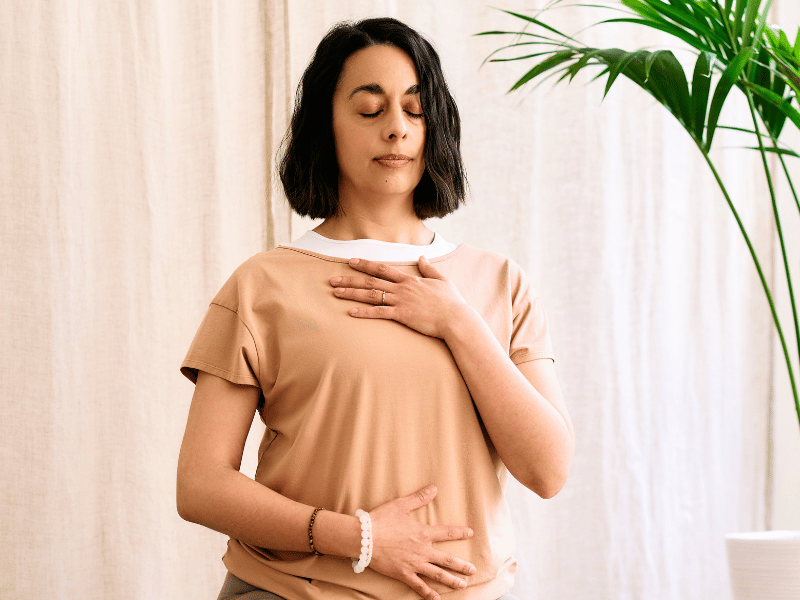Practising self-compassion helps to awaken our nurturing side as a way to self soothe and downregulate the threat response. Extending compassion to ourselves when we feel ‘less than’ or are navigating life’s challenges, is like a child being comforted by the loving embrace from a parent. It is a soothing balm that allows us to tap into the compassion response.
Below are 5 poses that you can tap into at any time of day to breathe and focus on channeling a sense of inner compassion towards yourself.
Compassionate Hug
This can be done anywhere but is especially nurturing when added either before or after a meditation practice.
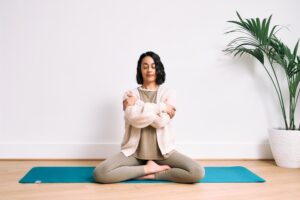
- Sit in a comfortable meditation posture. For this I have chosen Siddhasana or the Accomplished Pose.
- While sitting on a meditation cushion, bring one heel towards your groin. Then bring the opposite foot either on top or just in front of the first foot.
- Cross your arms over your chest, bringing your hands to your upper arms and give yourself a hug.
- You can apply some gentle pressure as you give yourself a squeeze. You may also like to rub your hands up and down your upper arms to build some warmth as you receive your self embrace.
- Mindful Mantra: May I give myself the compassion that I need.
Soothing touch with Loving Kindness mediation (cupping your hand over a fist over your heart whilst sitting in siddhasana)
As mentioned above, soothing touch allows us to tap into the compassion response as a way to calm and comfort ourselves. By placing one or two hands on our physical body in a warm, tender and caring way, we can support ourselves in feeling safe and comforted. Soothing touch releases oxytocin, often referred to as the ‘love hormone’, reduces cortisol and alleviates stress. This particular practice embodies the yin and yang of self-compassion. The yin of self-compassion represents “being with” ourselves in a compassionate way through comforting, soothing and validating ourselves. While the yang of self-compassion represents action and fierce compassion through protecting, providing and motivating ourselves.
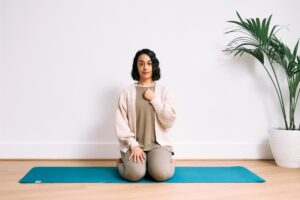

- Find a comfortable meditation posture. For this I have chosen Virasana or Hero’s Pose.
- From all fours, place the meditation cushion between your feet and slowly sit back with the heels just outside your hips and the knees together.
- Create a fist with one hand and place it over your heart (the yang of self-compassion).
- Cup your first with your other hand (the yin of self-compassion).
- Silently repeat to yourself this Loving Kindness meditation:
- May I be happy.
- May I be peaceful.
- May I be healthy.
- May I live with ease.
Supta Baddha Konasana (Reclined Bound Angle)
A quintessential restorative posture that supports nervous system regulation. This reclined posture creates space along the front body. It broadens the collarbones, opens the chest and creates more space for the lungs facilitating an easeful breath whilst also opening the hips and allowing the abdomen to soften. The act of self-care through restorative postures is about giving yourself the permission to slow down, soften and rest in order to replenish your energy and support nervous system health.
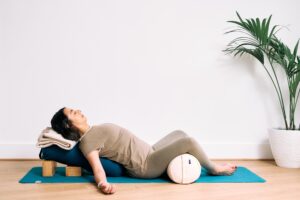
- Place one brick on its middle height at the top of your mat, followed by a second brick on its low height, just in front with some space between your bricks.
- Angle one bolster over the bricks to create an incline.
- Place a neatly folded blanket on top, with the smooth rounded edge towards you, to support the head.
- Sit on your yoga mat with your back facing your reclined bolster. Grab your second bolster and place under the backs of the highs as you bring the soles of your feet together.
- Slowly lie back over your bolster, making sure your head has the extra support of the folded blanket.
- Allow the arms to open out to the sides with palms face up.
- Optional: cover yourself with another blanket. You can also cover the eyes with an eye bag and/or place a sandbag over the feet for grounding.
- Stay for 20 minutes with your awareness on the breath.
- Mindful Mantra: I am at peace with myself and my surroundings.
Viparita Karani (Legs Up the Wall)
When your mind feels busy and frazzled, turning upside down can help to quieten an active mind and bring us back to the present moment. Inversions allow for blood flow to return back to the heart, known as venous return, as well as promoting lymphatic drainage from the lower parts of the body with the legs raised. Inversions also improve circulation, boost our energy and can clear the mind. Especially useful for those with anxiety.
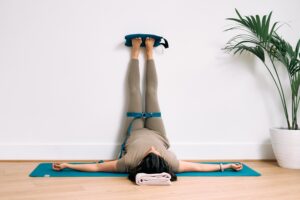
- Find a wall and place the small rectangular bolster a few inches away from the wall.
- Accordion fold a blanket to support the spine and head.
- Loop the strap and place this around the outer highs, tightening the strap to keep the legs together.
- Sit on one end of the bolster with one shoulder to the wall. Gently bring yourself down towards the floor and you roll to the side, bringing the back of your pelvis to the bolster and the legs up the wall.
- Place the sandbag on the tops of the feet for grounding.
- Stay for 20 minutes.
- Mindful Mantra: I release all negative thoughts and emotions and feel them drift away.
Supported Balasana (Child’s Pose)
The downward facing orientation of this posture can have a calming effect as the front body is supported, which encourages feelings of safety, whilst quieting the mind by turning inwards. The supported nature of the forward fold aids in relaxation and broadens the back body allowing for a deeper breath (the lungs have more space along the back of the body as they extend to the tenth rib).
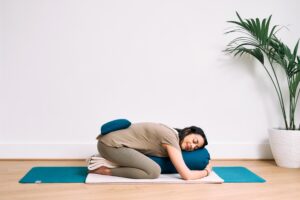
- Place two foam blocks in portrait orientation next to each other at the centre of your yoga mat. Put the bolster on top.
- Sit on your heels to one end of the bolster with the knees wide.
- Place a folded blanket between the sit bones and the heels for cushioning.
- Gradually lie over the bolster, with the knees hugging around the sides and the forearms resting on the ground.
- Turn the head to whichever side feels most comfortable.
- Optional: place a sandbag over the sacrum (back of the pelvis) for weight and grounding.
- Stay for 20 minutes, turning the head to the other side half way through.
- Mindful Mantra: I am at ease with myself and my thoughts.


